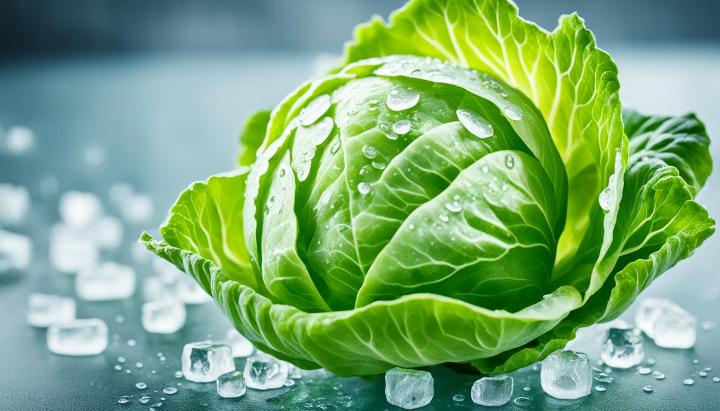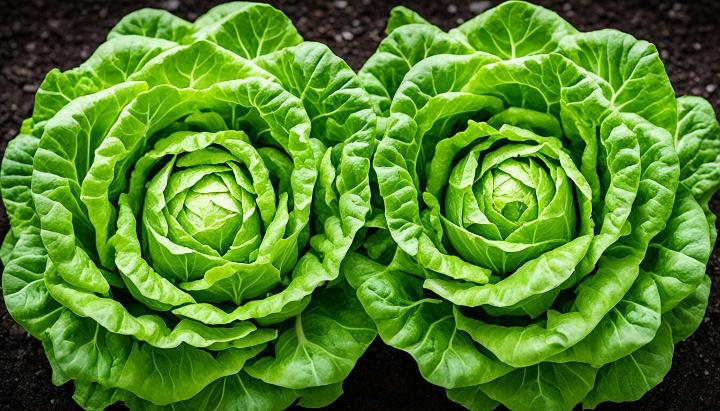Iceberg Lettuce Nutritional Value: Fact Check

When it comes to choosing nutritious greens for our salads, we often hear that darker lettuce varieties like spinach and kale are the superior choice. But what about iceberg lettuce? Is it just a bland and watery filler, or does it have any nutritional value worth considering?
In this article, we're here to fact check the nutritional value of iceberg lettuce and put any doubts to rest. We'll dive into the essential vitamins, minerals, and other nutrients present in this popular lettuce variety. Prepare to be surprised by what you'll discover about the unsung hero of salads.
Key Takeaways:
Iceberg lettuce has been criticized for its perceived lack of nutritional value.
We will fact check the nutritional value of iceberg lettuce to determine its true health benefits.
We will explore the vitamins, minerals, and other nutrients present in iceberg lettuce.
Iceberg lettuce can be a valuable addition to a balanced diet.
Don't underestimate the power of this crisp and refreshing green!
Nutritional Facts of Iceberg Lettuce: A Comprehensive Analysis
In this section, we will delve into the nutritional facts of iceberg lettuce to gain a better understanding of its nutrient content. Iceberg lettuce, known for its crisp and refreshing taste, offers a range of essential vitamins, minerals, and other beneficial compounds that contribute to a healthy diet.
Let's start by analyzing the calorie content of iceberg lettuce. This lettuce variety is extremely low in calories, making it a great choice for those who are watching their weight or looking for a low-calorie option. A single serving of iceberg lettuce, typically around one cup, contains only about 10-20 calories, depending on the size of the leaves.
Next, let's take a look at the fat content of iceberg lettuce. Similar to its calorie content, iceberg lettuce is virtually fat-free. This means that it's a low-fat addition to meals and can be enjoyed without worrying about excessive fat intake.
Moving on to carbohydrates, iceberg lettuce is also very low in carbs. A serving of iceberg lettuce contains only a small amount of carbohydrates, typically less than 3 grams. This makes it a suitable choice for individuals following a low-carb or ketogenic diet.
While iceberg lettuce is not a significant source of protein, it still provides a small amount. A serving of iceberg lettuce contains approximately 1-2 grams of protein. However, it's important to note that iceberg lettuce is not consumed primarily for its protein content, but rather for its refreshing taste and crisp texture.
When it comes to dietary fiber, iceberg lettuce offers a moderate amount. A serving of iceberg lettuce contains around 1-2 grams of fiber, contributing to your daily fiber intake. While it may not be as high in fiber as other lettuce varieties, such as romaine or spinach, iceberg lettuce still provides some valuable fiber to support a healthy digestive system.
In terms of sugar, iceberg lettuce is naturally low in sugar, making it a suitable choice for individuals who are watching their sugar intake. A serving of iceberg lettuce contains less than 2 grams of sugar, allowing you to enjoy its refreshing taste without worrying about excessive sugar consumption.
Now, let's highlight the various vitamins, minerals, and beneficial compounds found in iceberg lettuce. This lettuce variety is a good source of vitamin K, providing approximately 10-15% of the recommended daily intake per serving. It also contains small amounts of vitamin A, vitamin C, and folate.
Additionally, iceberg lettuce contains various minerals, including potassium, calcium, and iron. Potassium is essential for maintaining healthy blood pressurelevels, while calcium is important for strong bones and teeth. Iron plays a crucial role in oxygen transport within the body.
Comparing Iceberg to Romaine: A Battle of the Greens
In this section, we will compare iceberg lettuce to romaine lettuce in terms of their caloric content, fiber content, and nutrient profiles. Let's dive into the nutritional differences of these two popular salad greens and see which one comes out on top.
Caloric Content: Iceberg vs. Romaine
When it comes to calories, iceberg lettuce takes the lead. It is known for its low caloric density, making it a popular choice for weight-conscious individuals. On the other hand, romaine lettuce is slightly higher in calories but still remains relatively low on the calorie scale.
To give you a better idea, a 100-gram serving of iceberg lettuce contains approximately 14 calories, while the same serving size of romaine lettuce provides around 17 calories.
Fiber Showdown: Which Lettuce Takes the Lead?
When it comes to fiber content, romaine lettuce proves to be the winner. It contains more dietary fiber compared to its iceberg counterpart. A 100-gram serving of romaine lettuce contains an impressive 2 grams of fiber, while the same serving size of iceberg lettuce provides around 1 gram of fiber.
Fiber is an essential nutrient that promotes healthy digestion, helps control blood sugar levels, and aids in weight management. Including fiber-rich foods like romaine lettuce in your diet can contribute to overall health and well-being.
Vitamin and Mineral Comparison: Contrasting Nutrient Profiles
Both iceberg and romaine lettuce offer a variety of vitamins and minerals, but their nutrient profiles differ. Romaine lettuce is known for being rich in vitamin A, vitamin K, and folate. It also contains higher levels of minerals such as calcium and potassium.
On the other hand, iceberg lettuce may not have the same levels of vitamins and minerals as romaine, but it is still a good source of vitamin K and some other nutrients. It provides a refreshing crunch and can be a tasty addition to salads, sandwiches, and wraps.
When it comes to choosing between iceberg and romaine lettuce, it ultimately depends on your personal preferences and nutritional needs. Both lettuces can be a healthy addition to a balanced diet, providing essential vitamins, minerals, and fiber.

Does Iceberg Lettuce Have Any Nutritional Value?
In this section, we will address the question of whether iceberg lettuce has any nutritional value. Many people have questioned the nutrient content of iceberg lettuce compared to other lettuce varieties. We are here to provide evidence-backed information on the vitamins, minerals, and other beneficial compounds found in iceberg lettuce, highlighting its role as a valuable source of nutrients, so you can make an informed decision about incorporating it into your diet.
Iceberg lettuce may not have the dark green color commonly associated with highly nutritious greens, but it still offers some nutritional benefits. Let's take a closer look at the nutritional value of iceberg lettuce:
Iceberg lettuce is low in calories and is a good source of hydration due to its high water content.
While iceberg lettuce may not provide as many vitamins and minerals as its darker counterparts, it still contains essential nutrients that contribute to a balanced diet. Here is a breakdown of the nutritional content of iceberg lettuce per 100 grams:
Nutrient | Amount |
Calories | 14 |
Carbohydrates | 3.4 grams |
Fiber | 1 gram |
Protein | 0.9 grams |
Fat | 0.14 grams |
Vitamin K | 17 micrograms |
Vitamin A | 361 IU |
Vitamin C | 2.8 milligrams |
Potassium | 141 milligrams |
While these nutrient values may not be as high as other lettuce varieties, such as romaine lettuce or kale, they still contribute to a nutritious diet. Adding iceberg lettuce to your meals can provide hydration, fiber, vitamins, and minerals.
It's important to note that while iceberg lettuce alone may not provide all the necessary nutrients for optimal health, it can still be part of a healthy and balanced diet when combined with other nutrient-dense foods.
In the next section, we will explore the various health benefits of eating iceberg lettuce, so you can fully understand the advantages of incorporating this crisp and refreshing lettuce into your meals.
Lettuce Explore: The Health Benefits of Iceberg Lettuce
In this section, we will explore the health benefits of consuming iceberg lettuce. We will start by discussing its high water content and how it can contribute to hydration. We will then examine how the low energy density of iceberg lettuce makes it suitable for weight management. Finally, we will highlight the vitamins and minerals present in iceberg lettuce that are beneficial for heart health.
Hydration Hero: The High Water Content of Iceberg Lettuce
One of the remarkable health benefits of iceberg lettuce is its high water content. With over 95% water, this crisp and refreshing lettuce can play a significant role in keeping you hydrated throughout the day. Staying hydrated is essential for maintaining overall health and well-being, as water is necessary for various bodily functions, including digestion, circulation, and temperature regulation. Including iceberg lettuce in your diet can be an easy and delicious way to increase your daily water intake.
Assisting Weight Management: Low Energy Density of Iceberg
If weight loss is your goal, iceberg lettuce can be an excellent addition to your diet. This lettuce variety has a low energy density, meaning it provides fewer calories per gram compared to other foods. Its high water content and low calorie count make it a satisfying and filling option, helping you feel more satiated without consuming excess calories. Including iceberg lettuce in your meals can help promote weight loss or weight maintenance by contributing to a balanced and calorie-conscious diet.
Support for Heart Health: Vitamins and Minerals in Focus
Iceberg lettuce is not only refreshing, but it also offers a range of vitamins and minerals that are beneficial for heart health. It contains vitamin A, which plays a crucial role in maintaining healthy vision, immune function, and skin health. Additionally, this lettuce variety provides vitamin K, which is important for blood clotting and bone health. Minerals such as potassium, calcium, and magnesium are also present in iceberg lettuce, supporting proper heart function and contributing to a healthy cardiovascular system.

Creative Culinary Uses for Iceberg Lettuce in Diet-Friendly Meals
Incorporating iceberg lettuce into your diet doesn't have to be limited to plain salads. This versatile leafy green can be used in a variety of creative and diet-friendly meals. From adding crunch and freshness to wraps and sandwiches to serving as a unique vessel for flavorful fillings, iceberg lettuce offers endless possibilities for culinary exploration.
From Taco Boats to Tuna Roll-Ups: Innovative Meal Ideas
One fun way to incorporate iceberg lettuce into your meals is by using it as a substitute for traditional tortillas or bread. Create taco boats by filling large iceberg lettuce leaves with your favorite protein, such as seasoned ground turkey or grilled chicken, and topping them with colorful veggies and a dollop of Greek yogurt. These refreshing and low-carb taco boats are a healthy twist on a classic favorite.
Another idea is to use iceberg lettuce as a wrapper for tuna roll-ups. Simply spread a layer of tuna salad onto a lettuce leaf, add some sliced cucumber or avocado, and roll it up tightly. This light and flavorful option makes for a satisfying lunch or snack.
Get creative and experiment with other fillings and cuisines as well. Consider using iceberg lettuce leaves as a wrap for grilled vegetables or as a refreshing base for Asian-inspired lettuce wraps with marinated tofu or shrimp.
Storing and Preparing: Keeping Iceberg Fresh and Crisp
To ensure the freshness and crispness of iceberg lettuce, it's important to store and prepare it properly. Follow these tips to keep your lettuce at its best:
Refrigerate: Store iceberg lettuce in the refrigerator to maintain its crisp texture. Wrap it in a clean paper towel and place it in a breathable container or perforated plastic bag.
Washing: Before use, rinse the lettuce leaves under cold water to remove any dirt or debris. Gently pat them dry using a clean kitchen towel or paper towels.
Tearing or Cutting: Tear or cut the lettuce leaves right before serving to help prevent wilting. Use a sharp knife or tear the leaves by hand for a more rustic presentation.
Boosting Salads: Combining Iceberg with Nutrient-Dense Additions
To enhance the nutritional value of your salads featuring iceberg lettuce, consider adding nutrient-dense ingredients. Here are some flavorful options:
Protein Power: Incorporate lean proteins like grilled chicken breast, boiled eggs, or chickpeas to boost the protein content and make your salad more filling.
Healthy Fats: Add sliced avocado, a sprinkle of nuts or seeds, or a drizzle of extra virgin olive oil for a dose of heart-healthy fats.
Colorful Crunch: Include a variety of colorful vegetables like cherry tomatoes, bell peppers, shredded carrots, and red onions to add both crunch and a range of beneficial nutrients.
Superfood Boost: Consider adding nutrient-rich ingredients like quinoa, berries, or roasted sweet potatoes to pack your salad with extra vitamins and antioxidants.
With these creative culinary ideas, you can take your iceberg lettuce to new heights and enjoy its crisp texture and mild flavor in a variety of diet-friendly meals. Whether you're looking for a low-carb alternative to bread or tortillas or a refreshing addition to your salads, iceberg lettuce offers versatility and nutritional value that will surely elevate your dining experience.
Conclusion
It is clear that iceberg lettuce does have nutritional value, contrary to some misconceptions. While it may have a lower nutrient density compared to darker lettuce varieties, iceberg lettuce still offers a range of health benefits.
One of the main advantages of consuming iceberg lettuce is its high water content, which can contribute to hydration and support overall well-being. Additionally, its low energy density makes it a suitable choice for weight management, allowing individuals to enjoy a satisfying volume of food with fewer calories.







![[CBD1500C] Hammer CBD Tincture](/web/image/product.product/3671/image_256)
![[FBA1] Hammer Vegan Energy Bar (Almond - Raisin, 1 Serving)](/web/image/product.product/1286/image_256)